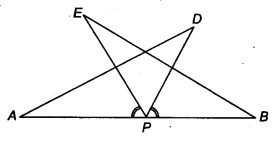NCERT Solutions for Class 9 Maths Exercise 7.1 Question 7

Understanding the Question 🧐
This question provides us with a line segment &&AB&& with a midpoint &&P&&. It also gives us some equal angles related to points &&D&& and &&E&&. Our goal is to use this information to prove two things: first, that two triangles are congruent, and second, that two sides are equal. This problem is an excellent exercise in applying the congruence rules, specifically the Angle-Side-Angle (ASA) rule.
AB is a line segment and P is its mid-point. D and E are points on the same side of AB such that &&∠BAD = ∠ABE&& and &&∠EPA = ∠DPB&&. Show that:
(i) &&ΔDAP ≅ ΔEBP&&
(ii) &&AD = BE&&

Step-by-Step Solution 📝
We will solve this problem in two parts as requested in the question. The solution to the second part depends directly on the result of the first part.
Part (i): Proving &&ΔDAP ≅ ΔEBP&& 📝
Step 1: List the Given Information
Let’s organize the information provided in the question.
- &&P&& is the mid-point of &&AB&&. This means &&AP = BP&&. This will be the “Side” in our ASA proof.
- &&∠BAD = ∠ABE&&. In the context of our triangles &&ΔDAP&& and &&ΔEBP&&, this means &&∠DAP = ∠EBP&&. This is one of the “Angles”.
- &&∠EPA = ∠DPB&&. This information needs a small adjustment to be useful for our triangles.
Step 2: Manipulate the Angles
To use the ASA rule on &&ΔDAP&& and &&ΔEBP&&, we need the angles &&∠APD&& and &&∠BPE&&. We are given &&∠EPA = ∠DPB&&. Notice that the angle &&∠EPD&& is common and can be added to both sides of this equation.
Starting with the given:
&&∠EPA = ∠DPB&&
Now, let’s add &&∠EPD&& to both sides:
&&∠EPA + ∠EPD = ∠DPB + ∠EPD&&
From the figure, we can see:
- &&∠EPA + ∠EPD&& forms the complete angle &&∠APD&&.
- &&∠DPB + ∠EPD&& forms the complete angle &&∠BPE&&.
&&∠APD = ∠BPE&&
Step 3: Prove Congruence using ASA Rule
Now we have two angles and the included side for both triangles. We can apply the ASA congruence rule.
In &&ΔDAP&& and &&ΔEBP&&:
- &&∠DAP = ∠EBP&& (Given)
- &&AP = BP&& (Given that P is the mid-point of AB)
- &&∠APD = ∠BPE&& (Proved in Step 2)
&&ΔDAP ≅ ΔEBP&&
This completes the proof for the first part.
Part (ii): Proving &&AD = BE&& 📝
Step 1: Use the Result from Part (i)
This part is a direct consequence of the first part. We have already proven that the two triangles are congruent.
From Part (i), we know that &&ΔDAP ≅ ΔEBP&&.
Step 2: Apply CPCTC
Since the triangles are congruent, all their corresponding parts (sides and angles) must be equal. This principle is known as CPCTC (Corresponding Parts of Congruent Triangles are Congruent).
Let’s identify the corresponding sides:
- Side &&AD&& in &&ΔDAP&& corresponds to side &&BE&& in &&ΔEBP&&.
&&AD = BE&&
Hence, the second part is also proved.
Conclusion and Key Points ✅
In this comprehensive ncert solutions guide, we successfully proved both parts of the question. For the first part, the key step was adding a common angle (&&∠EPD&&) to the given equal angles to obtain the necessary angles for the ASA congruence rule. For the second part, we simply applied the CPCTC rule to the congruent triangles established in the first part to show that sides &&AD&& and &&BE&& are equal.
- ASA Congruence Rule: Two triangles are congruent if two angles and the *included side* of one triangle are equal to the corresponding two angles and included side of the other triangle.
- Mid-point Property: A mid-point divides a line segment into two segments of equal length.
- CPCTC: A fundamental consequence of congruence. Once triangles are proven congruent, any pair of their corresponding parts are also equal.
FAQ
Q: What are the given conditions in Question 7 of Exercise 7.1?
A: The given conditions are: &&P&& is the mid-point of line segment &&AB&& (so &&AP = BP&&), &&∠BAD = ∠ABE&&, and &&∠EPA = ∠DPB&&.
Q: What is the first part we need to prove in this question?
A: In the first part, we need to prove that triangle &&DAP&& is congruent to triangle &&EBP&& (&&ΔDAP ≅ ΔEBP&&).
Q: Which congruence rule is used to prove &&ΔDAP ≅ ΔEBP&&?
A: The Angle-Side-Angle (ASA) congruence rule is used. We establish the equality of two angles (&&∠DAP = ∠EBP&& and &&∠APD = ∠BPE&&) and the included side (&&AP = BP&&).
Q: How do we prove that angle &&APD&& is equal to angle &&BPE&&?
A: We are given that &&∠EPA = ∠DPB&&. By adding the common angle &&∠EPD&& to both sides of this equation, we get &&∠EPA + ∠EPD = ∠DPB + ∠EPD&&, which simplifies to &&∠APD = ∠BPE&&.
Q: How do we prove that &&AD = BE&& in the second part?
A: After proving that &&ΔDAP ≅ ΔEBP&& in the first part, we can use CPCTC (Corresponding Parts of Congruent Triangles are Congruent). Since &&AD&& and &&BE&& are corresponding sides of these congruent triangles, they must be equal.
Q: Why is side &&AP&& equal to side &&BP&&?
A: It is given in the problem statement that &&P&& is the mid-point of the line segment &&AB&&. A midpoint divides a line segment into two equal parts, hence &&AP = BP&&.
Further Reading
To deepen your understanding of triangle congruence, you can refer to the official NCERT Class 9 Maths textbook on the chapter “Triangles”. Visit the official NCERT website for more educational materials: https://ncert.nic.in/.


